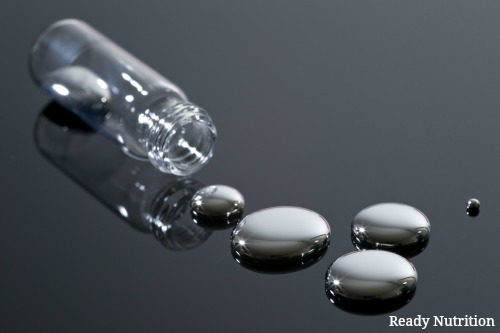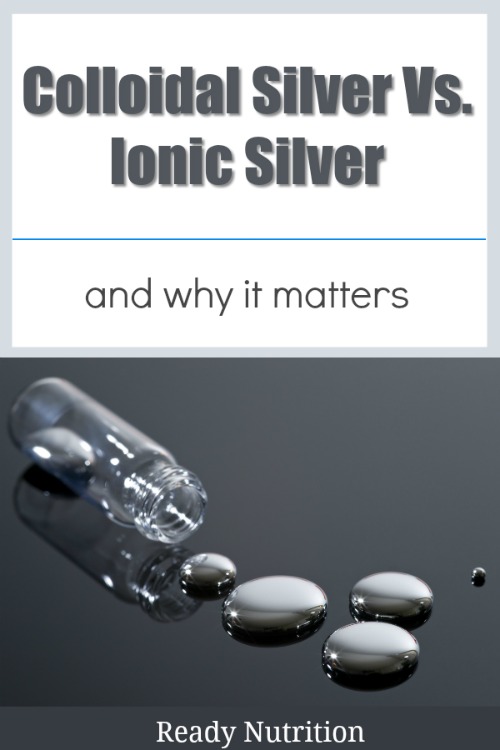
This article will help you to understand the differences and labeling so that informed decisions can be made about colloidal silver. Most don’t know that ionic silver is also often sold as colloidal silver, however, the differences between the two should be noted and for very important reasons.
What It Is
Colloidal silver is simply water with small nanoparticles of metallic silver in it. The silver particles are complete and do not combine with other elements. The same can not be said for ionic silver. If you’re more scientifically savvy than the average person, you’ve probably already guessed that ionic silver is an atom of silver that is missing an electron. The outermost electrons of an atom determine the physical properties of the matter. When one electron is taken away from a silver atom and you are left with a silver ion. Ionic silver is not the same as metallic silver, silver particles or colloidal silver.
Additionally, when that one electron is missing meaning the silver is in its ionic form, it is highly reactive with other elements, and will readily combine to form compounds. Pure silver particles, on the other hand, are made up of clusters of silver atoms and do not combine with other atoms of other elements, as their electron count is already “full.”
This is perhaps the most important fact to be kept in mind when reading claims that silver ions are particles. If a silver ion were a particle, it would not combine with chloride. Colloidal silver does have some ionic silver in it, however, because as the metallic silver goes through the process to become a colloid, some ions inevitably get in there.
This is noteworthy because silver ions and chloride ions have such a strong attraction for each other that it is virtually impossible to keep them apart. Once in contact with chloride ions, they will bond forming silver chloride. Silver chloride is an insoluble compound which means once it is formed in the human body, it does not dissolve. All ionic silver will eventually turn into silver chloride once inside the human body because of the readily available supply of chloride ions in many different forms. Silver chloride is an insoluble salt which is eliminated by the kidneys and expelled in the urine but it’s mostly useless as a supplement, making ionic silver much less desirable. Typical ionic silver products contain between 3 and 20 ppm of ionic silver which would not cause argyria (colloidal silver’s only known side effect).
Despite the fact that labels and advertising often never mention the words “ionic silver” or specify what percentage of the total silver in their product is made up of silver ions vs. silver particles, many different terms are being used to describe ionic silver products in an attempt to obfuscate the truth. The following terms are currently most often used: monatomic silver, silver hydrosol, and covalent silver.
Monatomic silver: simply an advertising term commonly used to describe ionic silver solutions. Claims for monatomic silver products describe their particles as single atoms of silver. Single-atom particles cannot exist due to the van der Waal’s force of mutual attraction which would cause single atoms to be drawn to each other to form particles consisting of clusters of atoms. For more in-depth details, please click here to read The Myth of Monatomic Colloidal Silver.
Silver Hydrosol: this is yet another term being used to sell ionic silver products. The definition of hydrosol is a colloidal suspension in water. Therefore, the term silver hydrosol is describing colloidal silver. However, products advertised as silver hydrosol are actually ads for ionic silver products that are typically 95% or more ionic silver.
Covalent silver: the most recent in the ionic name game. When you read the detailed description for covalent silver you will eventually find that the term is simply referring to silver ions.
Promotional claims made for some ionic silver products describe it as having “high bioavailability.” But that’s quite misleading. The Merck Manual is clear that bioavailability is the amount of unchanged drug that reaches the systemic circulation. To be bioavailable the substance being ingested must attain systemic circulation unchanged in form. Because silver ions are highly reactive they quickly form compounds in the body and therefore cannot remain unchanged. While it is the highly reactive nature of silver ions that provides its antimicrobial properties, it also causes the rapid formation of compounds and prevents the continued existence of silver ions inside the human body. Because silver ions cannot exist inside the human body the bioavailability is virtually nonexistent. Silver compounds such as silver chloride in the bloodstream provide no meaningful antimicrobial properties.
Only silver nanoparticles (colloids) can survive inside the body. Metallic silver particles are unaffected by hydrochloric stomach acid and chloride ions and will circulate in the bloodstream. The particles will slowly be eliminated from the body and do not build up. Since it is the particles of metallic silver that provide the real benefit, it is important to know how much of any colloidal silver product is in the form of particles.
Making a true silver colloid is a complicated, complex, and costly process. It’s no mystery why most producers choose to make ionic silver instead and simply call it colloidal silver. Thankfully, more consumers are educating themselves about this deception, and more are learning about this simple test: If it looks like water, it is ionic silver, not a true silver colloid.
There are many myths and some truths floating around about the side effects of colloidal silver as a supplement as well. Please go here to read about how to prevent the one known side effect of colloidal silver and what causes it to occur.

This article was originally published at Ready Nutrition™ on May 28th, 2018






